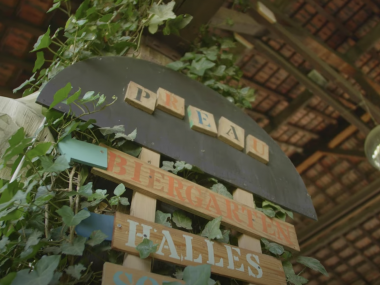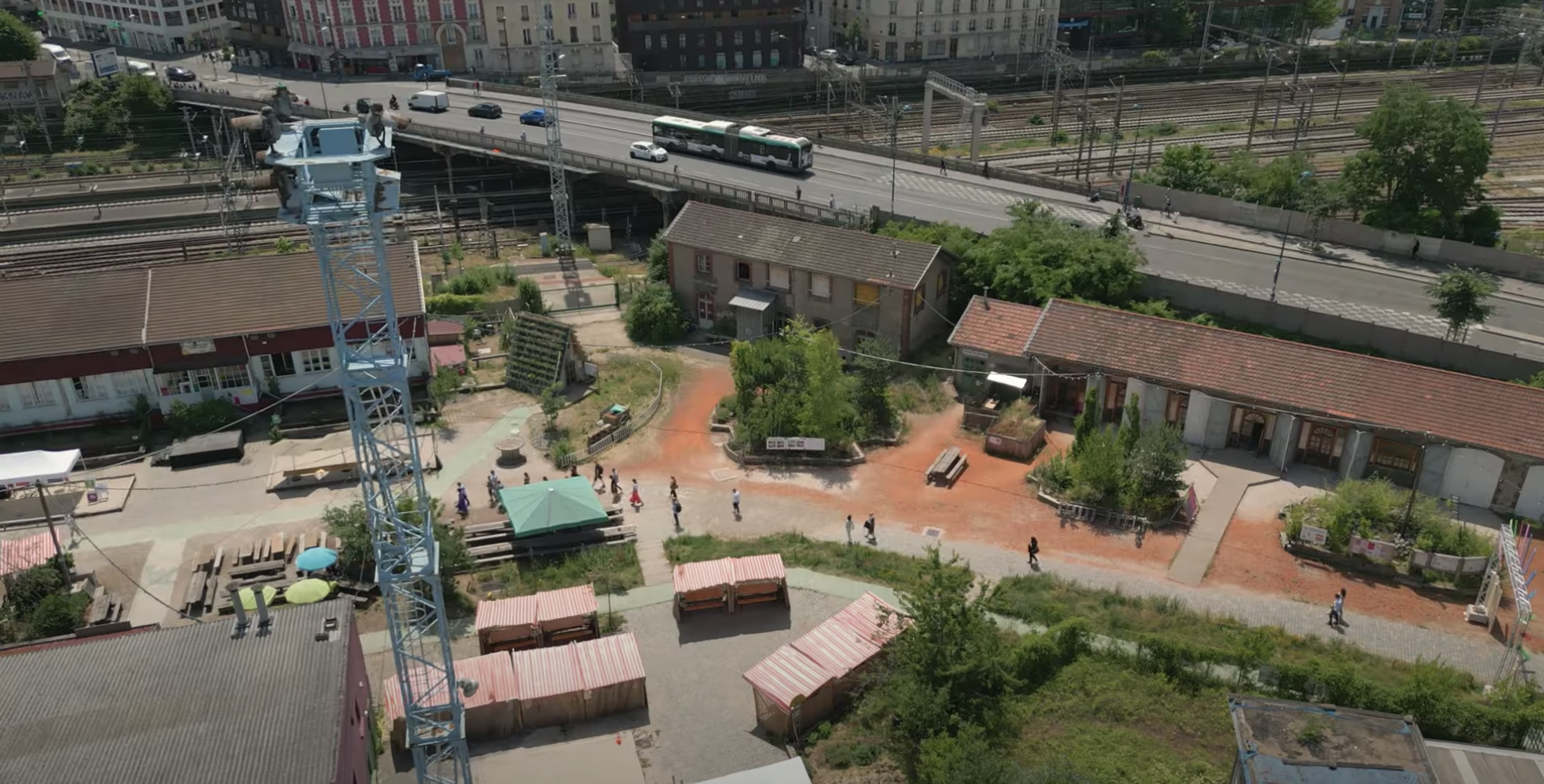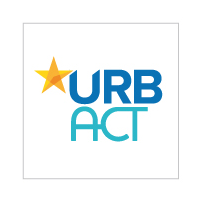A carbon-neutral URBACT City Festival, is it even possible?
Edited on
08 September 2022This year's edition of the City Festival brought many novelties, including carbon-neutral measures. Here are the take-aways from this experience!

With URBACT's growing commitment to the green transition, the core objectives from the French presidency in the Council of the EU 2022 under which the City Festival took place, the programme made the ambitious engagament to deliver its first carbon-neutral event ever. By uptaking this challenge, many lessons were learnt: from planning how to reduce the carbon footprint to engaging and nudging participants, to even eliminating emissions and alternatively compensating them.
Where to start – a plan to reduce emissions
Where do most of the emissions come from? Several aspects with a strong carbon footprint were identified, including the venue and meals.
The URBACT City Festival 2022 took place in La Cité Fertile (Pantin/Greater Paris), an ecological place owned by the French public transportation service (SNCF), which experiments with urban transition areas and temporary use. As an old logistics complex that has been provisionally transformed into a common space for leisure, La Cité Fertile uses exclusively renewable energy with no air conditioning. By using dry toilets, a lot of water is also saved. In addition, organic waste is systematically used in the composts.
exclusively renewable energy with no air conditioning. By using dry toilets, a lot of water is also saved. In addition, organic waste is systematically used in the composts.
Food and catering can be a tricky thing when planning any event. The meals served at the City Festival were either vegetarian or vegan, in order to reduce the carbon-footprint. Whenever possible, local seasonal ingredients were used in the recipes. Meals were precisely calculated and leftovers were distributed at the end of each day. The packaging for the meals was minimised and the URBACT team is very proud to say that there was no single-use plastic at the event. There is always room for improvement, of course, but these measures set a good reference for future events!
Unlike any other previous edition, this was a paper-less City Festival. Participants only brought home good memories and inspiration, as no welcome packs were produced. Instead of printing thousands of leaflets that would short-live, all the practical information from the event was gathered in a dedicated website. The URBACT cities, networks and other partners were invited to be creative when showcasing their outputs and results in the Exhibition, refraining from printing and mailing hundreds of long publications.
Before, during and after the event – communication campaign and travel
 When it comes to environmentally-friendly actions, it is impossible to ignore the elephant in the room: the travel carbon footprint. According to the French Agency for Ecological Transition (ADEME), on average travelling is responsible for 80% of an event’s emissions.
When it comes to environmentally-friendly actions, it is impossible to ignore the elephant in the room: the travel carbon footprint. According to the French Agency for Ecological Transition (ADEME), on average travelling is responsible for 80% of an event’s emissions.
Knowing this fact, the URBACT team decided to engage with potential participants and involve them in the carbon-neutral efforts from an early start. An awareness campaign was done prior to the City Festival, explaining the reasons behind the decision to organise a carbon-neutral event, but also on the ways we were doing it. This included a series of articles, messages and even an online guide with a carbon simulator. Participants became aware of the carbon footprint generated by their travel and URBACT encouraged them to choose different means of transportation than a plane.
Due to the current transportation infrastructure in Europe and the fact that the URBACT community includes urban enthusiasts from a wide diversity of countries, most participants still had to fly to France. Nevertheless, some participants took long-hour trains and alternative means of transportation to commit to our carbon-neutral challenge, with someone even facing a two-day train trip from Finland!
Looking back – harvesting the results and compensation measures
The City Festival finished on 16 June 2022, but the URBACT’s team work did not stop there! Now the time has come for the actual calculation of our event’s carbon footprint. The carbon accounting methodology evaluated the event’s emissions across the three scopes: direct emissions, indirect emissions related to energy consumption and other indirect emissions.
The total emissions amounted to 254 tonnes of CO2, an equivalent of 144 Paris - New York round trips or the annual emissions of 26 French people (Datagir by ADEME). It is therefore not an insignificant amount. The biggest chunk of emissions came, without surprise, from participants’ travels from all over Europe, accounting for 77.7% of the event’s carbon footprint, 78% of which was caused by using the plane.


The efforts to minimise the carbon footprint stemming from meals paid off: they accounted only for 1.4% of the total carbon footprint of the event, therefore 3.5 tCO2. Choosing a sustainable venue also proved to be the right choice, as our energy and building emissions amounted to only 0.6 tCO2 and 0.9 tCO2, respectively.
While the carbon footprint reductions were properly achieved, to reach the carbon-neutrality goal there was still one step left: compensating for the number of emissions to meaningful projects, as natural carbon sinks, which have the capacity to absorb and store greenhouse gases’ emissions. Two projects for our carbon offsetting were selected: afforestation and transition to sustainable agriculture in France.
The first project, Bois de l'Etang in North-eastern France, is focused on afforestation of plots currently used as meadows. A tree absorbs on average 25 kg of CO2 per year, therefore, developing forests is one of the best ways to support natural carbon dioxide absorption. The second chosen project focuses on the transition to sustainable agriculture. Supporting biodiversity is not only crucial for preserving life on Earth, but also soils can be powerful carbon sinks absorbing emissions.
At last, what lies ahead for URBACT events?
This year’s City Festival was the URBACT first, but certainly not the last, carbon-neutral event. With the upcoming URBACT IV, green transition will be mainstreamed across programme- and network-level activities. URBACT will continue to reduce its emissions by replacing some physical events by online ones, which have proliferated already during the Covid-19 pandemic. Whenever organising programme-level face-to-face events, the principle of carbon-neutrality will be kept, and strongly recommended for events organised by URBACT cities and networks.
So, yes! To reply to the title's question, it is possible to organise and deliver a carbon-neutral event, even if it's a large one for over 500 attendees.
City Festival participants doing some guerrila gardening in Pantin (France).
-

Green transition subjects are strongly present in capacity building activities for cities, with new tools enriching URBACT’s Toolbox, and in the URBACT Knowledge Hub. The URBACT IV Programme (2021 -2027) will retain the principle that cities will be free to select their own network themes according to their needs and priorities. Nevertheless, it will also explicitly aim to build the awareness and capacity of all programme actors “to better include cross-cutting considerations such as digital, environment and gender equality” in their work and activities both at programme and network-level.
 Submitted by URBACT on
Submitted by URBACT on





